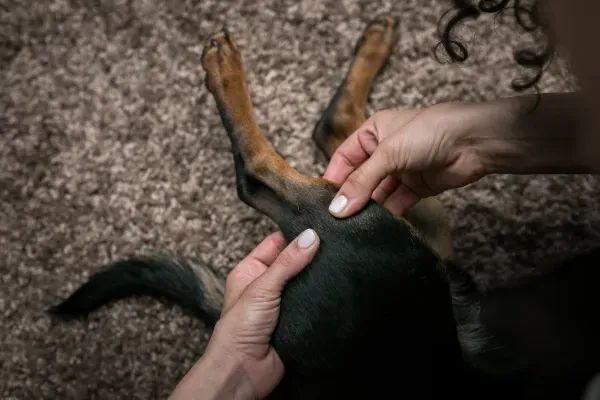
5 Simple Acupressure Techniques
5 Simple Acupressure Techniques Anyone Can Use to Help Their Anxious Pet
When your pet is experiencing anxiety—whether from thunderstorms, separation, or new environments—it can be heartbreaking to watch them suffer. As a pet parent, you want nothing more than to provide comfort and relief. While severe anxiety may require veterinary intervention, there are gentle, hands-on techniques you can use at home to help calm your animal companion's nervous system.
Traditional Chinese Medicine has recognized for thousands of years that strategic touch can activate the body's natural healing abilities. These ancient practices aren't just for humans—they can be remarkably effective for our animal companions too.

Why Acupressure Works for Anxious Animals
Acupressure—the application of gentle pressure to specific points on the body—works by stimulating the nervous system to release tension, increase circulation, and trigger the release of natural calming chemicals. For animals, it has several advantages:
Non-invasive: No needles, medications, or stressful procedures
Strengthens your bond: Creates a positive association with your touch
Portable: Can be performed anywhere your pet needs support
Empowering: Gives you practical tools to help your beloved companion
Dr. Narda Robinson, integrative veterinary medicine specialist, notes that "gentle acupressure can activate parasympathetic nervous system responses, helping anxious animals shift from 'fight or flight' to 'rest and digest' states."
Before You Begin: Setting the Stage for Success
Before trying these techniques, create a calm environment:
Find a quiet space where your pet feels safe
Ground yourself first with a few deep breaths (animals are incredibly sensitive to your energy)
Use a gentle touch with light to moderate pressure
Watch for feedback from your pet—they'll let you know what feels good
Keep sessions short (5-10 minutes) especially when starting out
5 Effective Acupressure Points for Calming Anxiety
1. GV 20: "Hundred Convergences" (Baihui)
Location: At the highest point on your pet's head, where the skull forms a slight depression along the midline.
How to apply: Use your thumb or index finger to apply gentle pressure in small, circular motions for 1-2 minutes.
Benefits: This powerful point helps clear the mind and calm the spirit. It's especially helpful for noise phobias and general anxiety.
Signs it's working: You may notice your pet lower their head, sigh, or close their eyes.
2. Yin Tang: "Hall of Impression"
Location: In the slight depression between the eyes, level with the inner eye corners.
How to apply: Use very gentle touch here, especially with cats and small dogs. Apply light pressure with your index finger for 30-60 seconds.
Benefits: This point is known for its ability to calm the mind and relieve anxious behavior. It's excellent for helping animals who seem overwhelmed by sensory input.
Signs it's working: Many pets will close their eyes or start to relax their facial muscles.
3. HT 7: "Spirit Gate"
Location: On the inside of the front leg, in the depression at the wrist crease (on the "pinky finger" side).
How to apply: Hold this point with gentle pressure for 1-2 minutes on each front leg.
Benefits: As its name suggests, this point helps calm the spirit and soothe emotional distress. It's particularly helpful for nighttime anxiety and restlessness.
Signs it's working: Your pet may sigh, relax their shoulders, or even become sleepy.
4. PC 6: "Inner Gate"
Location: On the inside of the front leg, about two inches above the wrist crease, between the tendons.
How to apply: Apply gentle pressure for 1-2 minutes on each front leg.
Benefits: This point helps relieve anxiety, nausea, and stress-related digestive issues—making it perfect for animals who experience stomach upset when anxious.
Signs it's working: You might notice your pet's breathing becoming deeper and more regular.
5. An Shen: "Calm the Spirit" Points
Location: Behind each ear, in the slight depression where the base of the ear meets the head.
How to apply: Gently massage both points simultaneously using your thumbs for 1-2 minutes.
Benefits: These paired points are renowned for their ability to calm nervous animals and help with sleep issues.
Signs it's working: Many pets will lower their head, relax their jaw, or lean into the touch.
Creating a Calming Routine
For best results, incorporate these techniques into a regular wellness routine, not just during anxious episodes. When your pet learns to associate your touch with relaxation, the calming effect begins the moment you place your hands on them.
A simple routine might include:
Start with gentle massage along the back to help your pet settle
Apply GV 20 (Hundred Convergences) for overall calming
Move to Yin Tang (between the eyes) for mental quieting
Finish with An Shen points behind the ears to deepen relaxation
When to Seek Professional Help
While these techniques can be remarkably effective for mild to moderate anxiety, they are complementary approaches, not replacements for veterinary care. If your pet's anxiety:
Interferes with daily functions like eating or sleeping
Leads to destructive or self-harming behaviors
Doesn't respond to calming techniques
Seems to be worsening over time
Consult with your veterinarian or a veterinary behaviorist about comprehensive treatment options.
Learn More with PAWS to Heal Together
Ready to deepen your understanding of how to support your pet through acupressure and other holistic techniques? PAWS to Heal Together offers comprehensive online courses and in-person workshops designed to empower you with practical, hands-on skills.
Our PAWS for Acupressure series teaches you how to locate and stimulate key points for various common conditions, while our nervous system regulation workshops help you understand how your energy affects your animal companion.
Amalia Reeves is a licensed acupuncturist with over 20 years of experience in human bodywork who is currently studying animal acupuncture. Through PAWS to Heal Together, she bridges traditional healing practices with modern understanding to support the wellbeing of animals and their human companions.
